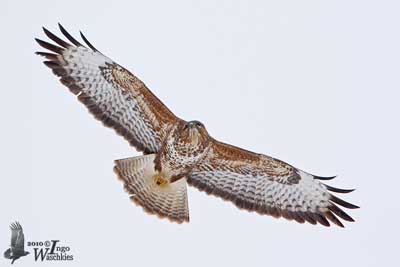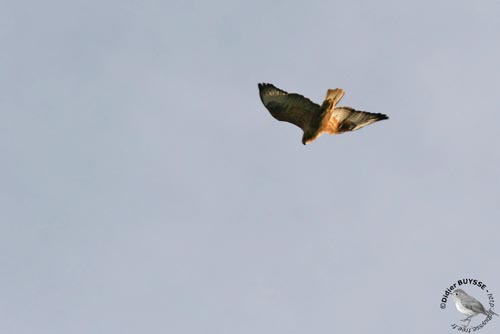
Text by Nicole Bouglouan
Photographers :
José Luis Beamonte
Pájaros de España
Didier Buysse
Vision d’Oiseaux
Tom Grey
Tom Grey's Bird Pictures
Eugène Montocchio
Galerie Photos Nature
Bob Moul
Nature Photography
Ingo Waschkies
My bird pictures on Pbase
Nicole Bouglouan
PHOTOGRAPHIC RAMBLE
Sources :
HANDBOOK OF THE BIRDS OF THE WORLD Vol 2 by Josep del Hoyo-Andrew Elliot-Jordi Sargatal - Lynx Edicions - ISBN: 8487334156
BIRDS OF PREY OF AFRICA AND ITS ISLANDS by Alan and Meg Kemp - Struik Publishers - ISBN: 1770073698
HAWKS, EAGLES AND FALCONS OF NORTH AMERICA by Paul A. Johnsgard - Smithsonian Institution Press - ISBN: 1560989467
GUIDE DES RAPACES DIURNES – Europe, Afrique du Nord et Moyen-Orient de Benny Génsbol – Delachaux et Niestlé – ISBN : 2603013270
Wikipedia, the free encyclopaedia
http://en.wikipedia.org/wiki/Main_Page
BirdLife International (BirdLife International)
http://www.birdlife.org/worldwide/index.html
Page article Hawks of genus Buteo - Introduction
Hawks of Genus Buteo
Hawks of the world, except Australia
3 - The hawk’ species present in several continents:
The Upland Buzzard (Buteo hemilasius) occurs in two morphs, from very pale to very dark.
In pale morph, the upperparts are brown with paler head and upper mantle which are brownish-white. Chin, throat and breast are white and heavily spotted dark brown. The belly is dark brown. Tail coverts and tail are white, the latter barred black. The bare parts are pale yellow and the bill is black.
In dark morph, the body plumage is dark brown, including head and underparts. The tail is slightly paler with black bars.
This buzzard is found in S Siberia and Mongolia, E to Manchuria and S to C China and SE Tibet.
It winter in N India, E China and Korea.
It frequents open areas such as steppes, grassy mountain slopes, grassland, but also rocky areas for nesting. It can be seen very high, up to 5000 metres of elevation in Tibet. In Japan, it is often seen in open cultivated areas.
The Upland Buzzard feeds mainly on various rodents, some small terrestrial birds from larks to grouses, bird’s eggs, amphibians and insects. It hunts while flying, looking at the ground, or from perch, or catches insects on the ground. This buzzard has partially feathered tarsi and small scales, suggesting some terrestrial hunting behaviour.
During the breeding season, the Upland Buzzard nests on rocky ledges, often protected by overhanging rock or vegetation. The nest is made with sticks and lined with soft materials such as wool and grass. The laying occurs in April-May. The female lays 2-4 eggs and the incubation lasts one month. Usually, only two chicks are reared, and they fledge about 45 days after hatching.
This species is migratory, with some birds wintering close to the breeding areas. They usually avoid the snow-covered regions.
The Upland Buzzard has very poorly known status. It is generally rare, but locally common in some regions, probably according to the prey availability.
The Long-legged Buzzard (Buteo rufinus) is slightly smaller than previous, with 50-65 cm length. This polymorphic raptor exhibits several morphs, dark, rufous and pale.
The bird in typical morph has pale head, neck, breast and tail. Belly is rufous. The upperparts are brown with darker flight feathers. The tail lacks the usual bars. The underwing shows dark carpal patches and rusty coverts. Trailing edge and wing tips are black.
In dark morph, the bird is dark brown with narrowly barred tail. On the underwing, the white secondary flight feathers are heavily barred black.
The rufous morph is slightly darker than paler morph, with darker underwing-coverts and rufous tinge overall.
The bare parts are yellow, with black bill and pale brown eyes.
The Long-legged Buzzard of nominate race is found is SE Europe and Asia Minor, Iran, Afghanistan to NW Mongolia and S to NW India. It winters in N Africa and N India.
The race “cirtensis” occurs in N Africa, from Mauritania to Egypt, and Arabia.

Long-legged Buzzard
Buteo rufinus
It frequents steppes, rocky country and semi-desert, open woodlands with clearings. It is visible from lowlands to mountains, and breeds from the coast up to 2500 metres or sometimes more, up to 3500 metres of elevation.
During winter, it frequents a great variety of habitats, from desert to cultivated and wooded areas.
It feeds on small mammals, reptiles, lizards and snakes. It also catches small birds, amphibians and large insects.
It hunts from perches, and can wait for long periods, and also on the ground. It perches on trees and rocks. It also forages by soaring while surveying the ground.
During the breeding season, both adults build the nest on cliff ledges or steep slopes, but also in trees when available. This is a bulky nest made with sticks and twigs, and lined with green leaves, wool and other softer materials. Sometimes, several nests can be seen in the same area.
The female lays 2-4 eggs in March-April, and the incubation lasts about 28 days. The chicks fledge 45 days after hatching.
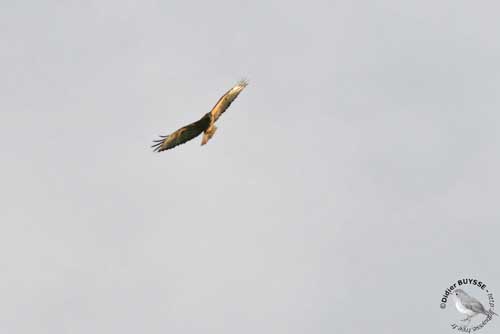
Long-legged Buzzard
Buteo rufinus
The Long-legged Buzzard of race “cirtensis” is sedentary and dispersive, whereas the nominate race is migratory, leaving the breeding grounds in late autumn, and returning in early spring. It also performs local movements according to the droughts.
The status of this species is poorly known, but some increases and recovering are observed and the bird is locally common in some parts of the range.
The Rough-legged Buzzard (Buteo lagopus) has variable plumage coloration, from dark to pale.
The upperparts are brown with faint scaled effect. The underparts are white and heavily spotted brown, but we can see an indistinct white breast collar. Uppertail-coverts are white, whereas the tail is barred black, with broad black subterminal bar and broad white base. On the underwing, coverts are spotted white and brown, flight feathers are white and trailing edge is black.
The head is paler, creamy-white, with darker chin and throat. The bare parts are yellow, the bill is black and the eyes are pale brown to yellow.
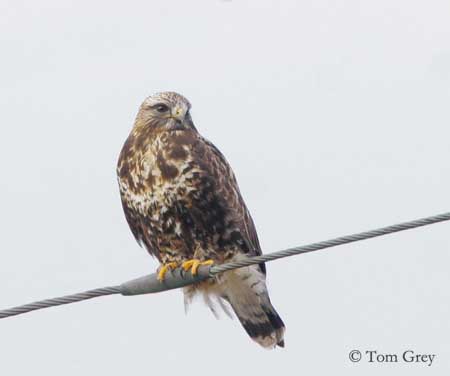
The subspecies “menzbieri” is much paler, almost white, with pale grey-brown upperparts and white underparts, except on the lower belly. The white tail is barred black as in previous race, and head, neck and breast are white, finely streaked pale brown.
The subspecies “sanctojohannis” is similar to nominate race, but it is darker above, heavily streaked brown on head, neck and breast, and flanks are dark.
In all races, we can see a white supercilium, more contrasted in dark birds. They differ in size and coloration.
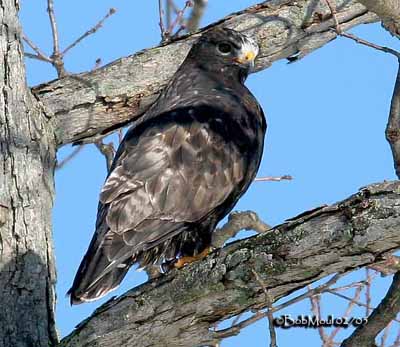
This buzzard is found in the northernmost parts of Europe, Asia and North America (where it is named “hawk” instead “buzzard”). It migrates southwards, in quite separate regions. The birds winter in south North America and C Europe and C Asia, according to the breeding range.
It mainly frequents the treeless tundra, but it also can be found in wooded tundra and extreme N taiga if lemmings and voles are abundant. It often occurs in flat lowlands, but in Norway, it is visible up to 1200 metres of elevation or more.
During winter, it always frequents open areas, cultivations, marshes and grasslands.
This species is very dependent on rodents and nest-sites availability.
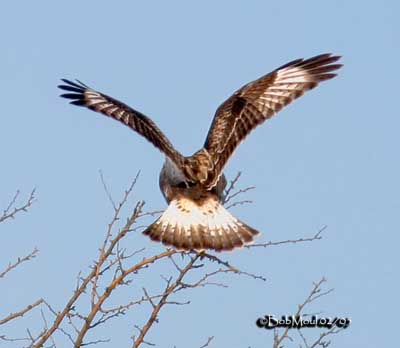
It feeds mainly on great variety of small mammals, and may catches small birds during the breeding season if lemmings and voles are scarce. Some grasshoppers, fish and carrion are occasionally taken.
It hunts from prominent perches, and may hover to detect the preys. It forages in open areas, and sometimes at dusk.
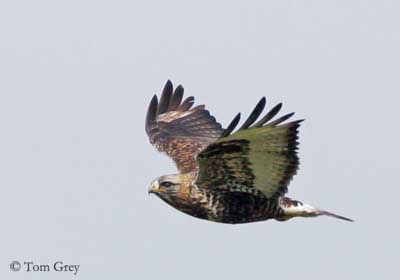
During the breeding season, the nest is built usually high on cliffs or rocky outcrops, on protected ledge. It is made with sticks and twigs, and lined with grass, sedges, hair and feathers. The nest can be placed in tree or slopes but rarely, and several nests are often fairly close together, and used in turn year after year. The female lays 3-5 eggs in May-June, and she incubates during about one month. The young fledge between 34 and 45 days after hatching, and they become independent 4-5 weeks later.
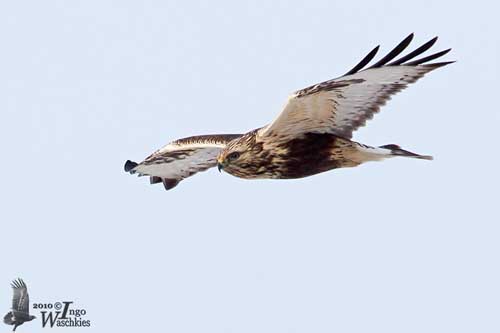
The Rough-legged Buzzard is widespread and fairly common in boreal regions where they are not disturbed by humans like on the wintering grounds. The populations seem to be stable and the species is not currently threatened.
Buteo lagopus
Buteo lagopus
Buteo lagopus
Buteo lagopus
The Eurasian Buzzard (Buteo buteo) could be the summary of all the previous species, as well in appearance as in behaviour. This stocky raptor has large wings and short tail, and in spite of its relatively short legs compared to those of the American hawks, it is able to walk on the ground when hunting for invertebrates.
In addition, its bulky silhouette leads us to the large and medium-sized eagles which will be the next study in the large family of the Accipitridae.
The Eurasian Buzzard has extremely variable plumage coloration. With 11 subspecies usually recognized, the variations of colours are great.
The typical Eurasian Buzzard has dark brown upperparts including wings and tail. Most of underparts and underwing-coverts are brown too, but the flight feathers are white with broad, black tips, and barred secondaries. The trailing edge is dark and we can see a dark carpal patch. The undertail feathers are white and finely barred black, with broad dark subterminal bar.
The bill is black with yellow cere. Eyes are dark brown. Legs and feet are yellow.
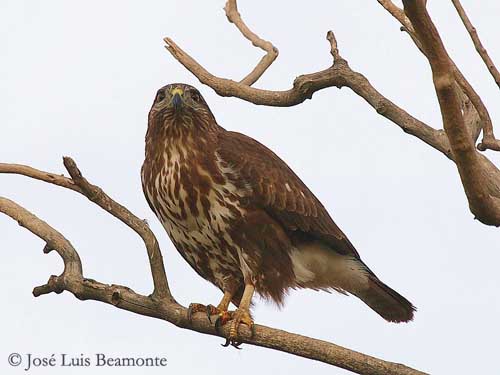
The plumage variations can be from almost white with dark flight feathers, through several tones of brown to slightly rufous upperparts and tail.
The Eurasian Buzzard breeds in Europe, except in extreme North of Scandinavia, Iceland and part or Ireland.
The populations living in the northernmost parts of Europe migrate southwards to winter in Africa, Israel and Arabia. The eastern birds winter in India, Indochina and China. Some Central European birds may move southwards to NW or W Africa. The populations of Britain, Southern Europe, Turkey, Caucasus, Japan and island’s birds are sedentary.
According to the different races, some of them are completely migratory. This is the case of the northern race “vulpinus” which winters in S Europe and SW Asia, travelling up to 13 000 km.
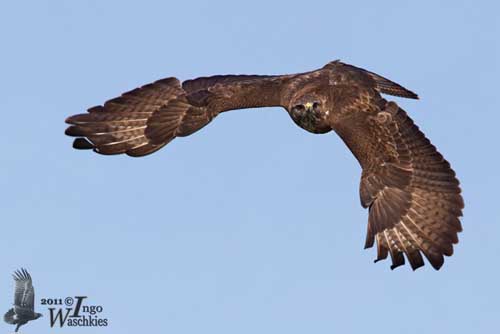
The Eurasian Buzzard frequents various types of habitats, but this raptor needs some trees for roosting and nesting. It is often found at forest edges, cultivated areas, meadows and pastures with scattered clumps of trees and woods.
During the winter, it is found in more open landscapes with some trees, such as open fields, steppes or even wetlands. It prefers flat areas or small slopes, but it also may be found above the tree-line in summer where it forages.
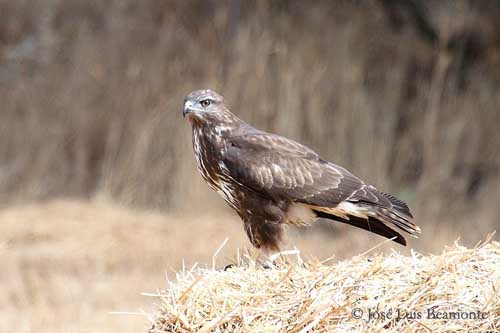
This buzzard is often seen perched on trees, poles, fences, or rocks, waiting for preys.
It feeds on small mammals, but it may adapt according to the food availability. Its diet usually includes up to 90% of rodents of numerous species such as mice, rats and others, but also young rabbits and hares. It also catches invertebrates, large insects, reptiles, worms and snakes. When mammals are scarce, it may hunt for birds such as pigeon, partridge or pheasant. Carrion is taken sometimes.
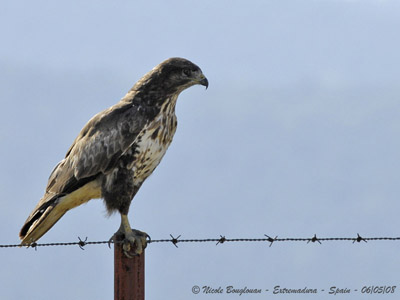
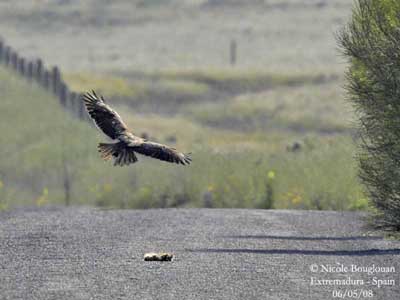
The Eurasian Buzzard hunts from perch where it spends long periods, waiting for prey. It forages at forest edges, in clearing and other open areas, and often catches the preys on the ground. It also detects the preys from soaring or gliding flight, and may hover before to dive. When hunting invertebrates, it walks on the ground.
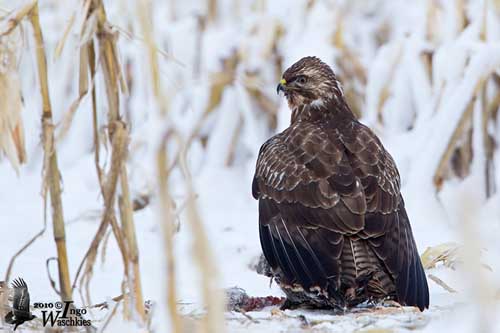
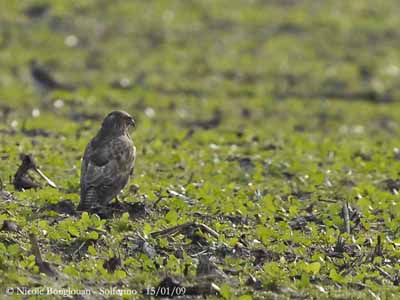
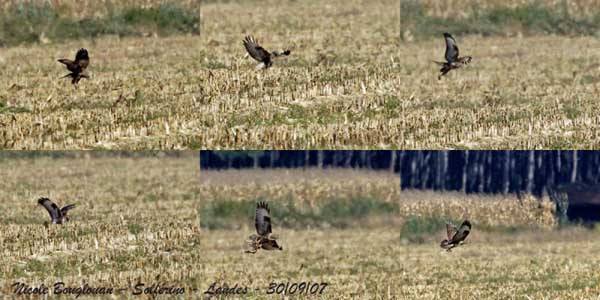
As a predator, this buzzard is sometimes mobbed by other birds’ species which perform chases around their nest.
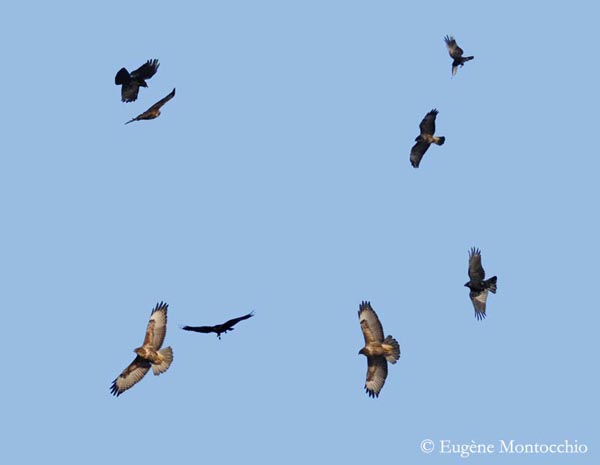
At the beginning of the breeding season, the Eurasian Buzzard performs circles in the air while calling as advertising signals. Aerial displays are observed with the pair rising high in the sky before to dive abruptly and to rise again. Sometimes, they can join their talons while flying. These are typical raptors’ flight displays.
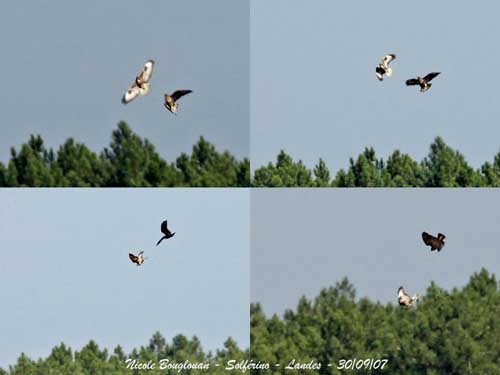
The nest is built in large tree, but occasionally on cliffs according to the range. This is a bulky platform made with sticks and twigs, lined with green vegetation. It is often placed near the trunk or in fork. As other species, this one may have several nests used in turn every year.
The female lays 2-4 eggs and incubates during about 33-38 days. She is fed by the male during this period, and the chicks are fed by both adults. They fledge 50-60 days after hatching and are independent 40-55 days later. They are sexually mature at 3 years.
The Eurasian Buzzard is one of the commonest raptors species in Europe. The populations are now stable after declines due to direct persecution, poisoning by baits, pesticides, habitat loss and rarity of preys. Increases have been observed in several parts of the range, but these raptors depend heavily on rodents and rabbits availability.
But currently, they are evaluated as Least Concern by Birdlife International.
As all the other raptors’ species, hawks and buzzards are very useful to clean the nature. They still are persecuted only because they are birds of prey. They are unobtrusive and shy birds, usually silent except during the breeding season and the displays. Why to persecute them? Fortunately, the laws protect these birds today, and the populations have recovered good numbers after severe declines in 20th century.
Enjoy their presence in the sky!
